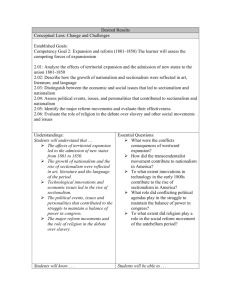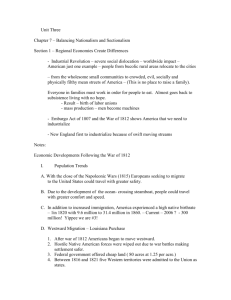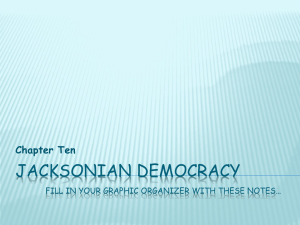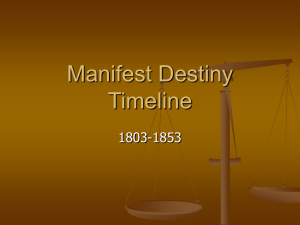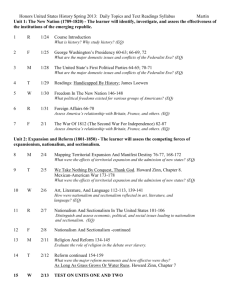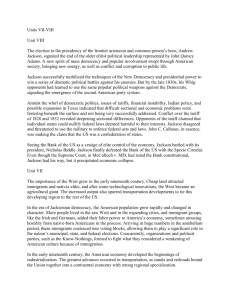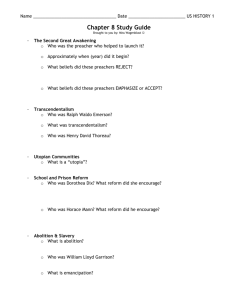08TAVMT Chapter 02
advertisement
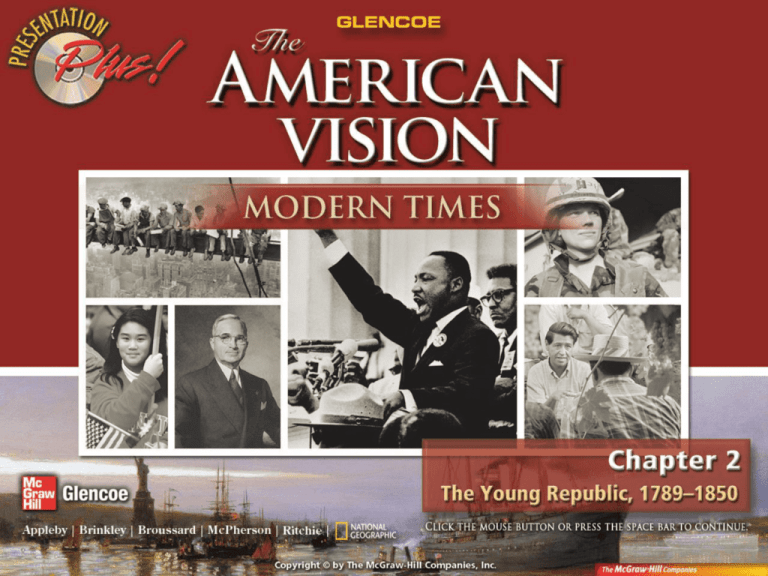
Chapter Introduction Section 1: The New Republic Section 2: The Growth of a Nation Section 3: Growing Division and Reform Section 4: Manifest Destiny and Crisis Visual Summary How Do Nations Grow? The young republic saw the growth of the federal government and nationalism. Sectional disputes began as industry developed in the North while Southern agriculture depended on slavery. As the nation expanded west, sectional conflict continued to escalate. • How did economic differences between North and South cause tensions? • How do you think the migration of settlers to the West affected the North and the South? The New Republic What steps did the United States take to establish a stable and lasting national government? The Growth of a Nation How did nationalism affect the development of the United States? Growing Division and Reform How did the Missouri Compromise seek to address growing sectionalism? Manifest Destiny and Crisis Why did westward expansion make sectional tensions worse? Big Ideas Government and Society An important Supreme Court decision asserted that the Court had the power to decide whether laws passed by Congress are constitutional. Content Vocabulary • cabinet • enumerated powers • Bill of Rights • implied powers • judicial review Academic Vocabulary • constitutional People and Events to Identify • District of Columbia • Louisiana Territory • Louisiana Purchase Which right guaranteed by the Constitution do you find most important and why? A. Yes B. No A. A B. B 0% A 0% B The Early Years of the Republic The United States established a federal government, created a Bill of Rights, and witnessed the first political parties. The Early Years of the Republic (cont.) • In the summer of 1789, Congress created three executive departments: − The Department of State − The Department of the Treasury − The Department of War • Washington then chose his cabinet. • Congress also organized the judicial branch. The Early Years of the Republic (cont.) • Ten of the twelve constitutional amendments proposed by Congress were approved. They are known as the Bill of Rights. Origins of the Bill of Rights The Early Years of the Republic (cont.) • Alexander Hamilton called for the creation of a national bank to manage the country’s finances. − However, Thomas Jefferson, James Madison, and others believed that the bank was not one of the federal government’s enumerated powers. − Hamilton rebuffed this criticism by stating that it was an implied power. The Early Years of the Republic (cont.) • Hamilton won approval for his financial program after promising to move the nation’s capital to the District of Columbia. • By 1794, factions in Congress solidified into two rival political parties: − Federalists—consisting of Hamilton’s supporters − Democratic-Republicans—consisting of Madison’s and Jefferson’s supporters The Early Years of the Republic (cont.) • Washington’s successor as president was John Adams. − One of his most urgent challenges was averting war with France. • Federalists passed the unpopular Alien and Sedition Acts in 1798. • The election of 1800 revealed a flaw in the system for electing the president. The Early Years of the Republic (cont.) • Thomas Jefferson became president and Aaron Burr became vice president. − This switch from the Federalist Party to the Democratic-Republican Party established that power could be peacefully transferred despite disagreements between political parties. Presidential Election of 1800 Manufacturers, merchants, and bankers would have belonged to which political party? A. Federalist B. Democratic-Republican A. A B. B 0% A 0% B Republicans in Power During the Jefferson administration, the Supreme Court established judicial review, and the country doubled in size. Republicans in Power (cont.) • Thomas Jefferson took office committed to limiting the scope of government. − He also wanted to weaken the Federalists’ control of the judiciary. • With the case of Marbury v. Madison, the Court asserted its right of judicial review. Republicans in Power (cont.) • Under Jefferson, the size of the country increased considerably. − Napoleon Bonaparte offered to sell all of the Louisiana Territory, as well as New Orleans, to the United States. − Congress overwhelmingly approved the Louisiana Purchase on April 30, 1803. The Louisiana Purchase, 1803 Republicans in Power (cont.) • When Republican James Madison became president in 1809, the British were antagonizing Americans. − Congress declared war, resulting in the War of 1812. − The Treaty of Ghent, signed on December 24, 1814, ended the war. − The treaty increased America’s prestige overseas and generated a new spirit of patriotism at home. Who was chief justice of the Supreme Court during this time? A. John Marshall B. Benjamin Franklin C. John Adams D. George Washington 0% A A. B. C. 0% D. B A B C 0% D C 0% D Big Ideas Science and Technology New technologies reshaped American industry. Content Vocabulary • revenue tariff • protective tariff • labor union Academic Vocabulary • transportation People and Events to Identify • “Era of Good Feelings” • John C. Calhoun • McCulloch v. Maryland • Monroe Doctrine • Industrial Revolution Are you aware of any recent Supreme Court decisions that have had a major effect on society? A. Yes B. No A. A B. B 0% A 0% B Growth of American Nationalism The surge of nationalism and the survival of only one political party made it possible to make economic and judicial decisions that strengthened the national government. Growth of American Nationalism (cont.) • After the War of 1812, a sense of nationalism swept the United States. − A Boston newspaper called this time the “Era of Good Feelings.” − James Monroe became the nation’s fifth president in 1816. Growth of American Nationalism (cont.) • After Republicans eliminated the First Bank of the United States, the results were disastrous. − In 1816 Representative John C. Calhoun introduced a bill proposing the Second Bank of the Unites States. • Protection of manufacturer from foreign competition was another part of the Republican program. Growth of American Nationalism (cont.) • Congress responded to the flow of cheaper British goods with the Tariff of 1816. − Unlike earlier revenue tariffs, this tariff was a protective tariff. • The Republicans also wanted to improve the nation’s transportation system. Building the National Road, 1811–1838 Growth of American Nationalism (cont.) • In many cases, between 1816 and 1824, John Marshall interpreted the Constitution broadly to support federal power. • Examples of cases are as follows: − Martin v. Hunter’s Lessee—the Court decided it had the authority to hear all appeals of state court decisions in cases involving federal statutes and treaties. Growth of American Nationalism (cont.) − McCulloch v. Maryland—the Court ruled that the “necessary and proper” clause allowed the federal government to use its powers in any way not specifically prohibited by the Constitution. − Gibbons v. Ogden—the Court ruled that states could regulate commerce only within their borders, but that control of interstate commerce was a federal right. Growth of American Nationalism (cont.) • Postwar nationalism also influenced foreign affairs. − During the 1800s, Spanish-held Florida was a source of frustration for Southerners. − Eventually, Spain gave in and ceded all of Florida to the United States in the AdamsOnis Treaty of 1819. Growth of American Nationalism (cont.) • With the threat of European countries, as well as Russia, claiming territory in the United States, Monroe issued the Monroe Doctrine in 1823. During Monroe’s presidency, which of the following was not a focus? A. The banking system B. Transportation C. Tariffs D. The military 0% A A. B. C. 0% D. B A B C 0% D C 0% D A Growing Nation New industries and railroads transformed the North in the early 1800s, while slavery expanded in the South. A Growing Nation (cont.) • With the United States expanding rapidly, Americans sought new ways to connect the distant regions of the country. − New roads, steamboats, and trains were three of the ways by which this was accomplished. • The Industrial Revolution, which began in Britain in the mid-1700s, spread to the United States. A Growing Nation (cont.) • The United States industrialized quickly for several reasons: − The American system of free enterprise based on private property rights − The era’s low taxes − General incorporation laws that made it much easier to start businesses A Growing Nation (cont.) • Between 1815 and 1860, more than 5 million foreigners journeyed to America. − Some Americans, such as the KnowNothings, had feelings of nativism. • By 1860, factory workers numbered roughly 1.3 million. − Hoping to gain higher wages or shorter workdays, some workers began to organize into labor unions. A Growing Nation (cont.) • Despite the trend toward urban and industrial growth, agriculture remained the country’s leading economic activity. − In 1793 Eli Whitney invented the cotton gin, transforming cotton production in the South. A Growing Nation (cont.) • The spread of cotton plantations boosted the Southern economy, but it also made the demand for slave labor skyrocket. − All enslaved persons, no matter how well some were treated, suffered indignities. An Economy Built on Enslaved Labor, c. 1850 Which form of transportation contributed the most to connecting different regions in the early 1800s? A. Steamboats B. Trains C. Wagons D. Cars 0% A A. B. C. 0% D. B A B C 0% D C 0% D Big Ideas Government and Society The American political system became more democratic during the Jacksonian era. Content Vocabulary • spoils system • benevolent societies • secede • temperance • emancipation Academic Vocabulary • controversy • exposure People and Events to Identify • Missouri Compromise • Tariff of Abominations • Trail of Tears • Whigs • Second Great Awakening • Frederick Douglass Is there any part of our society that needs reform? A. Yes B. No A. A B. B 0% A 0% B The Resurgence of Sectionalism Sectionalism increased after the War of 1812, while voting rights expanded for American citizens. The Resurgence of Sectionalism (cont.) • Tensions rose to a boiling point in 1819, when Missouri’s application for statehood stirred up the country’s most divisive issue: whether slavery should expand westward. • The Senate decided to admit Maine as a free state and Missouri as a slave state, known as the Missouri Compromise. − They also added an amendment to prohibit slavery in the rest of the Louisiana Territory north of Missouri’s southern The Missouri Compromise boundary. The Resurgence of Sectionalism (cont.) • John Quincy Adams won the disputed election of 1824. − Andrew Jackson’s supporters called themselves Democrats, while Adams and his supporters called themselves National Republicans. The Resurgence of Sectionalism (cont.) • Throughout the first decades of the 1800s, hundreds of thousands of white males gained the right to vote. − The campaign that year pitted John Quincy Adams against Andrew Jackson again. − Jackson won and actively tried to make the government more inclusive. − Jackson vigorously utilized the spoils system. The Resurgence of Sectionalism (cont.) • The Jacksonians replaced the caucus with the national nominating convention. • When Congress levied yet another new tariff in 1828—which critics called the Tariff of Abominations—many South Carolinians threatened to secede from the Union. − When Congress passed yet another tariff law, South Carolina voted to nullify the law. − Jackson considered their action treason and sent a warship to Charleston. The Resurgence of Sectionalism (cont.) − Henry Clay insisted that Congress pass a bill that would lower tariffs gradually until 1842, diffusing the situation. • In 1830 Jackson signed the Indian Removal Act. • Chief Justice John Marshall supported the Cherokee in two court decisions, but Jackson refused to carry out the decision. − Roughly 4,000 Cherokee died before and during the Trail of Tears. Effects of the Indian Removal Act, 1831–1842 The Resurgence of Sectionalism (cont.) • President Jackson also decided to dismantle the Second Bank of the United States. • By the mid-1830s, those who criticized Jackson’s decision had formed a new political party, the Whigs. The Resurgence of Sectionalism (cont.) • Democrat Martin Van Buren succeeded Jackson and took office as a crippling economic crisis hit the nation. − He did little to ease the crisis, and a Whig candidate, General William Henry Harrison, won the 1840 election. − After Harrison’s death, John Tyler, a former Democrat, took office. The following reasons caused the economic crisis during Van Buren’s presidency EXCEPT A. Jackson’s issue of the Specie Circular D. An absence of a National Bank 0% 0% 0% D C. A lack of gold A 0% A B C D C A. B. C. D. B B. A lack of paper credit The Reform Spirit The Second Great Awakening brought an era of reform. The Reform Spirit (cont.) • In the early 1800s, religious leaders organized to revive America’s commitment to religion, called the Second Great Awakening. • Other religious groups besides Protestants flourished, including: − Unitarians − Universalists − Mormons The Reform Spirit (cont.) • Associations known as benevolent societies focused on spreading the word of God and attempting to convert nonbelievers. − They also sought to combat a number of social problems. The Reform Spirit (cont.) • Although advocates of temperance had been active since the late 1700s, the new reformers energized the campaign. − In 1833 the American Temperance Union was formed. − Maine passed the first state prohibition law. • Other reformers focused on prisons and education. The Reform Spirit (cont.) • Women did not have the right to vote in the 1800s. − In 1848 activists Lucretia Mott and Elizabeth Cady Stanton organized the Seneca Falls Convention in New York. − This gathering marked the beginning of an organized women’s movement. The Reform Spirit (cont.) • Many of the country’s founders knew that the nation would have difficulty remaining true to its ideals if it continued to enslave human beings. − Early antislavery societies advocated gradual reform. − The American Colonization Society (ACS) encouraged African Americans to resettle in Africa. The Reform Spirit (cont.) • William Lloyd Garrison, in his newspaper, the Liberator, called for the immediate emancipation of enslaved persons. • Many women and free African Americans took a prominent role in the abolitionist movement. − Frederick Douglass and Sojourner Truth worked hard to end slavery. The Reform Spirit (cont.) • Some Northerners objected to abolitionism because they considered it a dangerous threat to the existing social system. • Most Southerners vehemently defended the institution of slavery. Of all the reform movements, which one was the most divisive? A. Social reform B. The women’s movement C. The abolitionist movement D. Religious reform 0% A A. B. C. 0% D. B A B C 0% D C 0% D Big Ideas War, Trade, and Migration War with Mexico brought new territories under the control of the United States and increasing discord about slavery. Content Vocabulary • popular sovereignty • secession Academic Vocabulary • resolution • civil People and Events to Identify • Manifest Destiny • James K. Polk • Treaty of Guadalupe Hidalgo • Compromise of 1850 • Underground Railroad • Harriet Tubman • Kansas-Nebraska Act • Dred Scott Do you agree that citizens are sometimes justified in disobeying the law? A. Agree B. Disagree A. A B. B 0% A 0% B Manifest Destiny In the 1840s the nation expanded as settlers moved west. Manifest Destiny (cont.) • Most emigrants, like the majority of Americans, believed in Manifest Destiny. − Latecomers to the Midwest set their sights on California and Oregon. − By the 1840s, several east-to-west routes had been carved, including the Oregon Trail, the California Trail, and the Santa Fe Trail. Overland Trails West, 1840–1860 Manifest Destiny (cont.) • At first, Mexico had encouraged Americans to settle the Mexican region of Texas. − Stephen Austin and Sam Houston decided to separate from Texas and create their own government after tensions developed with Mexico. Manifest Destiny (cont.) • The citizens of Texas voted in favor of joining the United States. − Texas statehood became a key issue in the presidential race of 1844. − James K. Polk, a Democrat, beat Henry Clay, a Whig. Manifest Destiny (cont.) • In December 1845 Texas became a state. − Texas’s entry into the Union outraged the Mexican government. • On May 13, 1846, the Senate and House voted in favor of war with Mexico. − Defeated Mexico’s leaders signed the Treaty of Guadalupe Hidalgo on February 2, 1848. The War with Mexico, 1846–1848 Why did the United States declare war on Mexico? A E. A and C 0% 0% 0% 0% 0% E D. A and B A B C D E D C. A Mexican force attacked the U.S. troops first. C B. Mexican forces began attacking Americans in California. A. B. C. D. E. B A. Mexico’s president refused to discuss a solution with the United States. Slavery and Western Expansion Continuing disagreements over the westward expansion of slavery increased sectional tensions between the North and South. Slavery and Western Expansion (cont.) • In mid-1846 Representative David Wilmot proposed that any territory the United States had gained from Mexico should be a free state. • Senator Lewis Cass suggested the citizens of each new territory be allowed to decide for themselves if they wanted to permit slavery, a policy known as popular sovereignty. Slavery and Western Expansion (cont.) • By the end of 1849, over 80,000 “FortyNiners” had arrived in California hoping to find gold. − California applied to enter the Union as a free state in December 1849. − At the time, the union consisted of 15 free states and 15 slave states. − A few Southern politicians began to talk of secession if California tipped the balance. Slavery and Western Expansion (cont.) • In early 1850 Henry Clay tried to find a compromise that would enable California to join the Union and resolve other sectional disputes. − By September, Congress had passed all parts of the Compromise of 1850. Slavery and Western Expansion (cont.) • As part of the Compromise of 1850, Henry Clay had convinced Congress to pass the Fugitive Slave Act as a benefit to slaveholders. − The law actually hurt the Southern cause by creating active hostility toward slavery among many Northerners. Slavery and Western Expansion (cont.) • One reason that so many African Americans could escape from the South was the Underground Railroad. − Harriet Tubman was the most famous conductor. • Harriet Beecher Stowe’s book, Uncle Tom’s Cabin, had such a dramatic impact on public opinion that many historians consider it a cause of the Civil War. Slavery and Western Expansion (cont.) • The opening of the Oregon country and the admission of California to the Union brought further problems as the nation expanded. • Many people became convinced of the need for a transcontinental railroad to promote growth in the territories along the route. − The choice of the railroad’s eastern starting point was contentious. Slavery and Western Expansion (cont.) • Despite opposition, Congress passed the Kansas-Nebraska Act in May 1854. • By March 1856, Kansas had two governments, one opposed to slavery and the other supporting it. − “Bleeding Kansas,” as newspapers dubbed the territory, had become the scene of a territorial civil war. − Kansas finally became a free state in 1861. The disputed starting points for the transcontinental railroad were which two cities? A. Chicago and Philadelphia D. Los Angeles and Boston 0% 0% D 0% A B C D C 0% A C. New Orleans and Chicago A. B. C. D. B B. The District of Columbia and Philadelphia The Crisis Deepens The slavery controversy shook up political parties and accelerated the crisis between North and South. The Crisis Deepens (cont.) • During the congressional elections of 1854, many Northern Whigs joined forces with Free-Soilers and a few antislavery Democrats to organize the Republican Party. • The Know-Nothing Party began to come apart when the Upper South section split with the Northern section over the Northerners support for the Kansas-Nebraska Act. • Democrat James Buchanan defeated Republican John C. Fremont and KnowNothing Millard Fillmore in the 1856 election. The Crisis Deepens (cont.) • Chief Justice Roger B. Taney ruled against Dred Scott in the case Dred Scott v. Sanford. − Taney claimed that African Americans were not citizens and therefore could not sue in the courts. • About a year after the second rejection of the Lecompton constitution, national attention shifted to John Brown, a fervent abolitionist who opposed slavery not with words but with violence. The Crisis Deepens (cont.) • After seizing the arsenal at Harpers Ferry, Virginia, Brown was captured and sentenced to death. − Many Northerners saw Brown as a martyr in a noble cause. Whose main goal was to stop Southern planters from becoming an aristocracy that controlled the government? A. The Republican Party B. The Know-Nothings C. The Democratic Party 0% A A. A B. B 0% C. C B 0% C A Growing Nation Political Developments • Washington creates the first cabinet; Supreme Court is established. • The Bill of Rights is added to the Constitution. • The first political parties develop; the convention system emerges. • Voting rights are widely extended to free adult men. • Women begin to seek voting rights. • United States fights the War of 1812 against Britain. A Growing Nation Political Developments • Supreme Court asserts power to overturn laws in Marbury v. Madison. • The United States issues the Monroe Doctrine. A Growing Nation Economic Developments • Canals, railroads, and roads are built linking the nation together. • Factories open in the North; cotton farming spreads across the South. A Growing Nation Territorial Growth • The Louisiana Purchase doubles the size of the nation. • The United States obtains Florida from Spain. • The United States annexes Texas and divides Oregon with Britain. • United States acquires the Southwest and California after the war with Mexico. A Growing Nation An Emerging National Culture • Religious revivalism triggers movements to reform education, prisons, and asylums, and reduce alcohol consumption. • New American literature is written. A Divided Nation Economic Differences • North’s economy is based on small family farms, trade, and small-scale industrial production. • South’s economy is based on enslaved labor on plantations and farms. A Divided Nation Political Conflict • Missouri Compromise divides territories into areas where slavery is and is not permitted. • Jackson threatens to use force to ensure federal authority over South Carolina in the Nullification Crisis. • Abolitionism emerges in the North; Southern anxiety grows. • Underground Railway develops to help enslaved people escape to the North. • Uncle Tom’s Cabin builds support for abolition but enrages Southerners. A Divided Nation Political Conflict • Compromise of 1850 angers both North and South. • Northerners openly defy the Fugitive Slave Act. • Kansas-Nebraska Acts lead to fighting between proslavery and antislavery settlers. • Dred Scott ruling allows slavery in territories, angering Northerners. • John Brown’s raid terrifies and angers Southerners. Chapter Transparencies Menu Why It Matters Cause-and-Effect Transparency Unit Time Line Transparency Select a transparency to view. cabinet a group of advisers to the president Bill of Rights a summary of fundamental rights and privileges guaranteed to a people against violation by the state enumerated powers powers listed in the Constitution as belonging to the federal government implied powers powers not specifically listed in the Constitution but claimed by the federal government judicial review power of the Supreme Court to determine whether laws of Congress are constitutional and to strike down those that are not constitutional being in accordance with or regulated by a constitution revenue tariff tax on imports for the purpose of raising money protective tariff tax on imports designed to protect American manufacturers labor union an organization of workers formed for the purpose of advancing its members’ interests transportation method of travel from one place to another spoils system practice of handing out government jobs to supporters; replacing government employees with the winning candidate’s supporters secede to leave or withdraw benevolent society an association focusing on spreading the word of God and combating social problems temperance moderation in or abstinence from alcohol use emancipation the act or process of freeing enslaved persons controversy a prolonged public dispute exposure the condition of being unprotected, especially from severe weather popular sovereignty government subject to the will of the people; before the Civil War, the idea that people living in a territory had the right to decide by voting whether slavery would be allowed there secession withdrawal from the Union resolution a formal expression of opinion, will, or intent voted by an official body or assembly civil of or relating to citizens To use this Presentation Plus! product: Click the Forward button to go to the next slide. Click the Previous button to return to the previous slide. Click the Home button to return to the Chapter Menu. Click the Transparency button from the Chapter Menu, Chapter Introduction, or Visual Summary slides to access the transparencies that are relevant to this chapter. From within a section, click on this button to access the relevant Daily Focus Skills Transparency. Click the Return button in a feature to return to the main presentation. Click the History Online button to access online textbook features. Click the Reference Atlas button to access the Interactive Reference Atlas. Click the Exit button or press the Escape key [Esc] to end the chapter slide show. Click the Help button to access this screen. Links to Presentation Plus! features such as Maps in Motion, Graphs in Motion, Charts in Motion, Concepts in Motion, and figures from your textbook are located at the bottom of relevant screens. This slide is intentionally blank.

